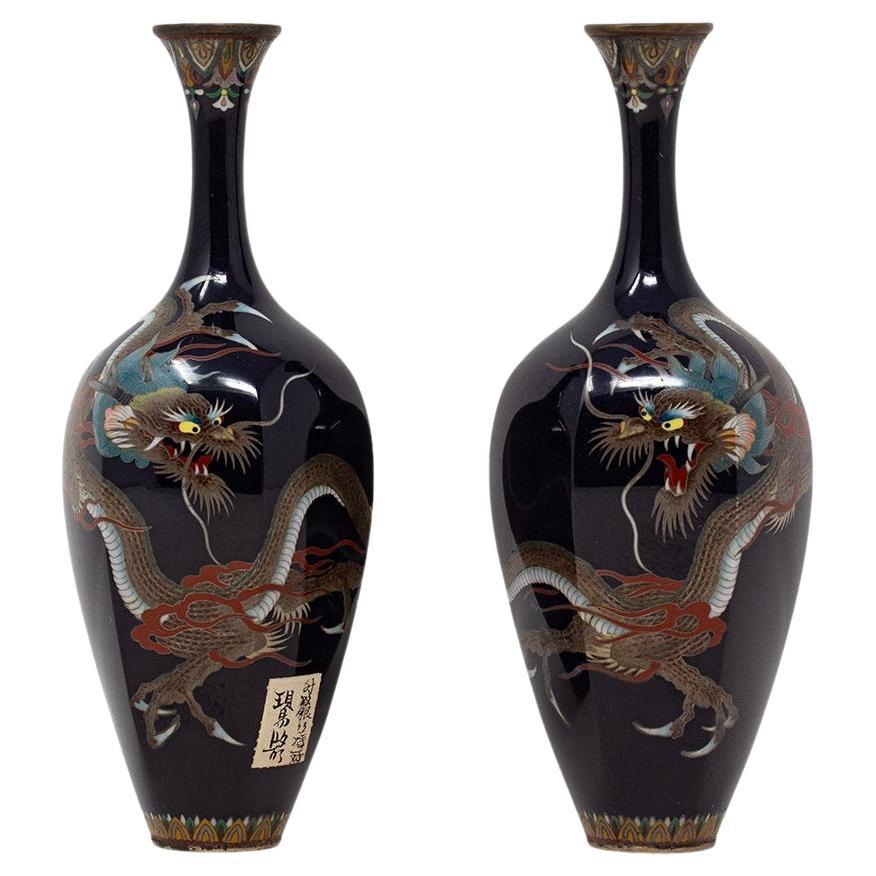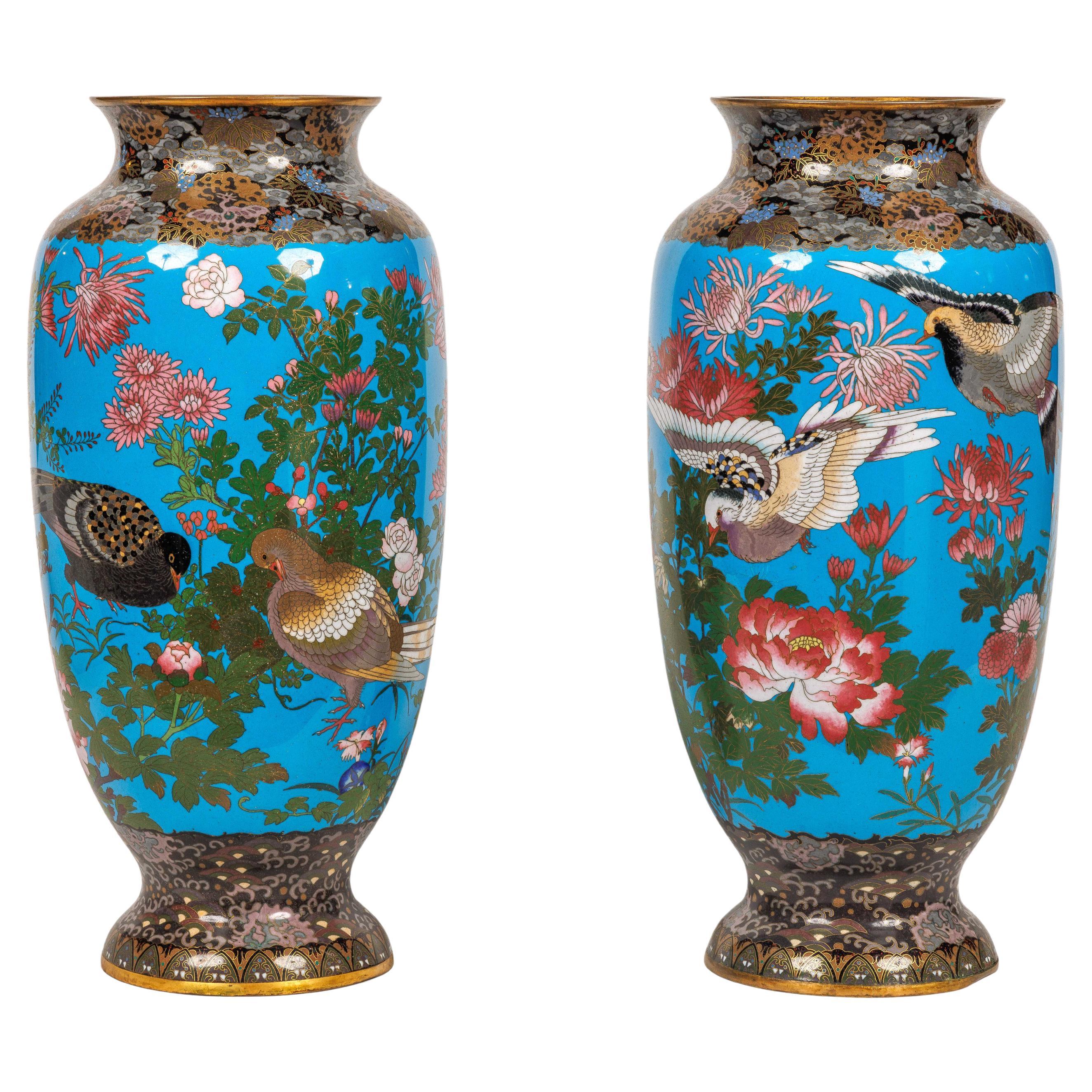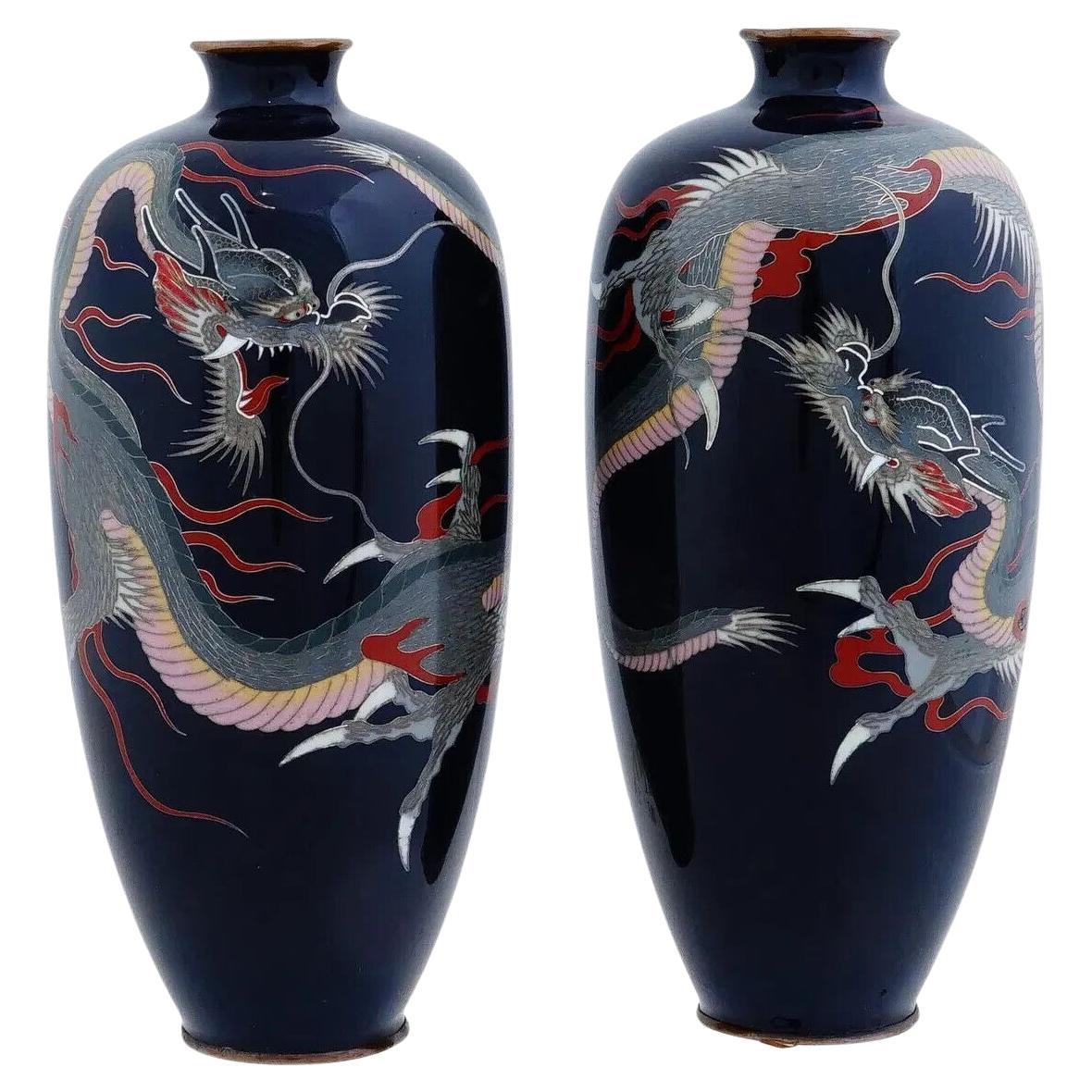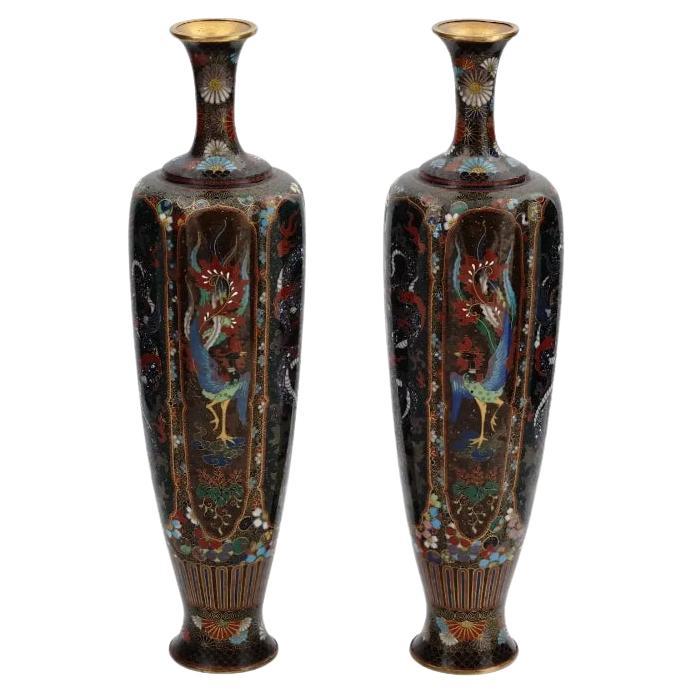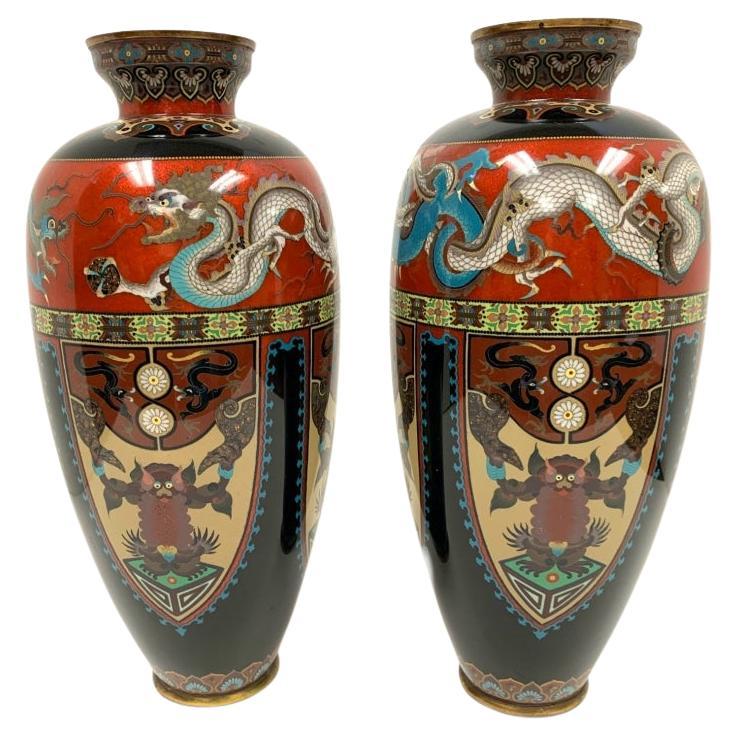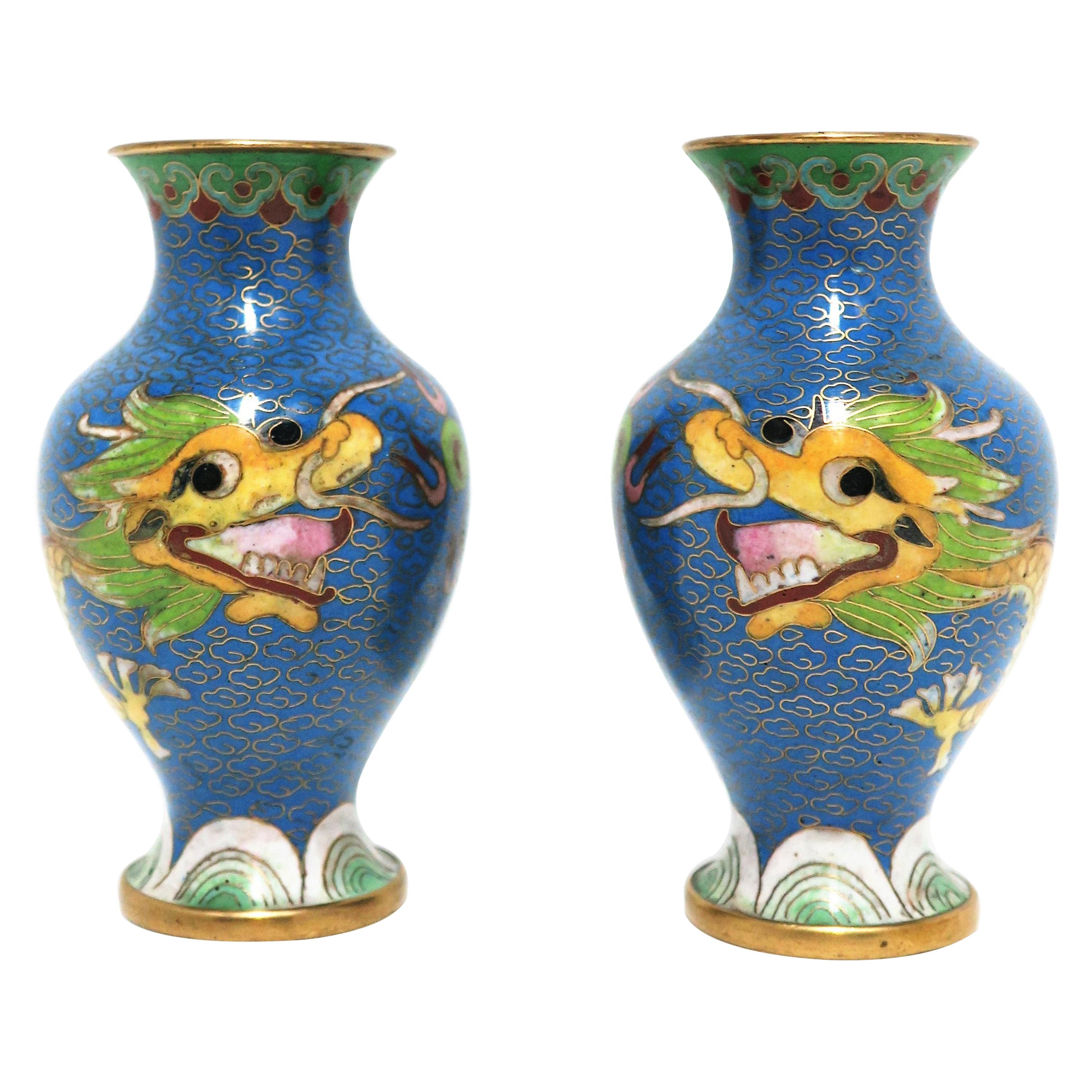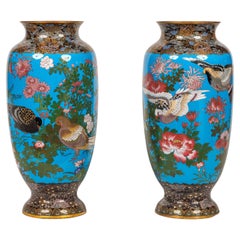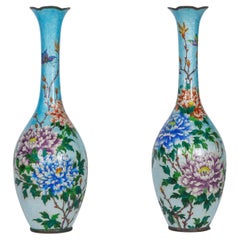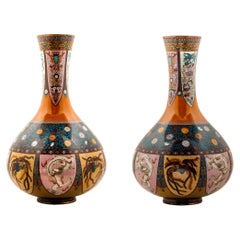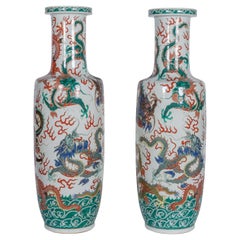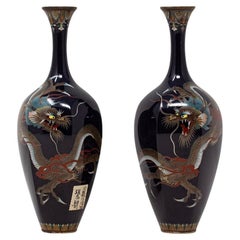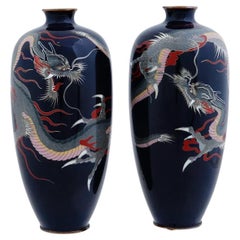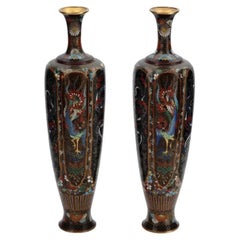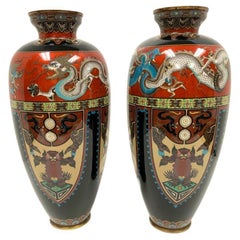Items Similar to Large Pair of Meiji Period Japanese Cloisonne Enamel Double Dragon Vases
Video Loading
Want more images or videos?
Request additional images or videos from the seller
1 of 18
Large Pair of Meiji Period Japanese Cloisonne Enamel Double Dragon Vases
$65,000
£49,346.89
€56,442.32
CA$90,814.43
A$101,005.46
CHF 52,741.92
MX$1,229,129.07
NOK 673,594.74
SEK 631,713.03
DKK 421,250.64
Shipping
Retrieving quote...The 1stDibs Promise:
Authenticity Guarantee,
Money-Back Guarantee,
24-Hour Cancellation
About the Item
A large pair of Meiji Period Japanese Cloisonne Enamel Double Dragon Vases, 19th century.
Japanese cloisonne enamel dragon vases are highly sought after by collectors and art enthusiasts around the world. These vases were made during the Meiji era, which lasted from 1868 to 1912, and were produced using a technique called cloisonne enamel.
Cloisonne enamel involves creating compartments or cells, typically using metal wires, on a metal object and then filling the cells with colored enamel paste. The object is then fired in a kiln to fuse the enamel and create a smooth, glossy surface.
The dragon is a symbol of power and strength in Japanese culture, and it is often depicted in art and mythology. These vases feature intricate designs and vibrant colors, with the double dragons on each vase depicted in various poses and settings.
Measures: 24" high x 10" diameter
Very good condition, slight scratches normal with age and use.
- Dimensions:Height: 24 in (60.96 cm)Diameter: 10 in (25.4 cm)
- Style:Meiji (Of the Period)
- Materials and Techniques:
- Place of Origin:
- Period:
- Date of Manufacture:19th Century
- Condition:Wear consistent with age and use.
- Seller Location:Queens, NY
- Reference Number:1stDibs: LU1798233534652
About the Seller
5.0
Vetted Professional Seller
Every seller passes strict standards for authenticity and reliability
Established in 1980
1stDibs seller since 2016
63 sales on 1stDibs
Typical response time: 5 hours
- ShippingRetrieving quote...Shipping from: Queens, NY
- Return Policy
Authenticity Guarantee
In the unlikely event there’s an issue with an item’s authenticity, contact us within 1 year for a full refund. DetailsMoney-Back Guarantee
If your item is not as described, is damaged in transit, or does not arrive, contact us within 7 days for a full refund. Details24-Hour Cancellation
You have a 24-hour grace period in which to reconsider your purchase, with no questions asked.Vetted Professional Sellers
Our world-class sellers must adhere to strict standards for service and quality, maintaining the integrity of our listings.Price-Match Guarantee
If you find that a seller listed the same item for a lower price elsewhere, we’ll match it.Trusted Global Delivery
Our best-in-class carrier network provides specialized shipping options worldwide, including custom delivery.More From This Seller
View AllLarge Pair of Meiji Period Japanese Cloisonne Enamel Vases Attributed to Goto
Located in Queens, NY
A large pair of Meiji Period Japanese cloisonne enamel vases attributed to Goto Seizaburo, 19th century.
These vases were made during the Meiji period (1868-1912) in Japan and are characterized by their blue enamel background with intricate designs of flowers, birds (including pigeons), butterflies and landscapes.
The use of blue enamel as a background creates a striking contrast with the colorful designs, making these vases particularly visually appealing which are appreciated for their beauty, craftsmanship, and cultural significance.
Goto Seizaburo (1852-1914) was a renowned Japanese cloisonne enamel artist...
Category
Antique 19th Century Japanese Meiji Metalwork
Materials
Copper, Enamel
$20,000 Sale Price
20% Off
An Exquisite and Large Pair of Meiji Japanese Ginbari Cloisonne Enamel Vases
Located in Queens, NY
An Exquisite and Large Pair of Meiji Japanese Ginbari Cloisonné Enamel Vases with Peonies and Butterflies
This stunning pair of vases, crafted during the Meiji period (1868-1912), s...
Category
Antique 19th Century Japanese Meiji Vases
Materials
Enamel
Large Pair of Japanese Cloisonne Enamel Vases Attributed to Honda Yasaburo
Located in Queens, NY
A large pair of Japanese Cloisonne Enamel vases attributed to Honda Yasaburo, 19th century.
Finley decorated with the rich enamel colors of orange and green, these vases are desig...
Category
Antique 19th Century Japanese Meiji Metalwork
Materials
Copper, Enamel
A Highly Rare Pair of Monumental Qing Dynasty Rouleau Porcelain "Dragon" Vases
Located in Queens, NY
A Highly Rare Pair of Monumental Qing Dynasty Rouleau Porcelain "Dragon" Vases
A Masterful Display of 19th Century Chinese Artistry:
The mid-19th century Qing Dynasty marked a period of artistic innovation and imperial grandeur, as exemplified by this rare and monumental pair of Rouleau vases. These exceptional porcelain works, notable for their commanding size and vibrant palette, are a testament to the unparalleled craftsmanship that flourished during this era. Embellished with a dynamic tableau of dragons rendered in bold hues of red, green, blue, brown, and yellow, these vases embody both artistic brilliance and the deep cultural symbolism woven into Chinese decorative arts.
Artistic Excellence and Symbolism:
At the heart of these magnificent vases lies a visual narrative that channels the power and mystique of the dragon, a central motif in Chinese culture symbolizing imperial authority, strength, and cosmic energy. The intricate depiction of dragons in motion, intertwined amidst stylized ocean waves, conveys a sense of fluidity and dynamic movement. Each color used—the crimson reds, verdant greens, striking blues, earthy browns, and golden yellows—has been meticulously applied, reflecting a mastery of the high-fired, polychrome enameling techniques perfected during the Qing Dynasty.
The Rouleau form, with its cylindrical body, short neck, and slightly flared mouth, was a favored shape for large-scale vases in the 18th and 19th centuries. The form’s structured elegance allowed for expansive decorative panels, serving as an ideal canvas for intricate, multi-layered designs. This pair demonstrates how artisans skillfully balanced the flowing movement of the dragons with the rhythmic motifs of waves, resulting in a harmonious composition that engages the viewer from every angle.
Craftsmanship and Technique:
These vases represent the pinnacle of porcelain artistry achieved under the Qing Dynasty, showcasing techniques that reflect centuries of refined craftsmanship. The precision in the application of overglaze enamels and the expert manipulation of kiln temperatures to achieve vibrant and consistent coloration are indicative of the expertise within the imperial kilns. The dragons' scales, rendered with remarkable detail, create a textured effect that contrasts beautifully with the smooth, undulating waves, enhancing the three-dimensional quality of the design.
The depth of color and the crisp delineation of each element point to a rigorous and time-intensive process. These qualities signify the involvement of highly skilled artisans who adhered to the imperial standards set by the royal court, ensuring that each piece was a fitting representation of the empire’s wealth and cultural prowess.
Historical and Cultural Significance:
Vases of this caliber were not merely decorative; they were imbued with profound symbolic meaning and often commissioned for imperial use or gifted as prestigious diplomatic offerings. The dragon motif, deeply embedded in Chinese folklore and philosophy, was associated with the emperor himself—known as the "Son of Heaven"—and symbolized his divine right to rule. These vases also reflect the Qing Dynasty's flourishing export trade and the global fascination with Chinese porcelain during the 19th century. European collectors and royal patrons prized such pieces for their artistry and the exoticism they represented, contributing to a legacy that elevated Chinese porcelain to a revered status in the annals of decorative art history.
Provenance and Collectability:
The extraordinary scale, exceptional craftsmanship, and rarity of this pair establish them as museum-quality works. Such vases would have held a place of honor in a palace or wealthy estate, reflecting not only the owner’s status but also an appreciation for the profound cultural and artistic traditions of China. Their provenance—potentially tied to an imperial commission or significant historical collection—underscores their importance as objects of study and admiration.
Provenance:
Private American Collection, acquired in London, circa 1905.
Thence by descent to the current owners
Solomon Treasure...
Category
Antique Mid-19th Century Chinese Qing Ceramics
Materials
Porcelain
An Exquisite Pair Of Japanese Cloisonné Enamel Vases with Chrysanthemum Blossoms
Located in Queens, NY
An Exquisite Pair Of Japanese Cloisonné Enamel Vases with Chrysanthemum Blossoms, Attributed to Hayashi, Meiji Period.
Experience the exquisite craftsmanship of the Meiji period wit...
Category
Antique 19th Century Japanese Meiji Metalwork
Materials
Enamel
A Large Pair of Japanese Cloisonne Pink-Ground Vases Featuring Sunset and Cranes
Located in Queens, NY
Presenting a truly captivating and highly collectible pair of Meiji Period Japanese Cloisonné Enamel Pink-Ground Vases, attributed to the renowned artist Hayashi Kodenji. These excep...
Category
Antique 19th Century Japanese Meiji Vases
Materials
Enamel
You May Also Like
Antique Japanese Cloisonne Enamel Vase Pair Hayashi School
Located in Newark, England
Meiji Period (1868-1912)
From our Japanese collection, we are delighted to offer this pair of Antique Japanese Cloisonne Enamel Vases by the Hayashi School in their Original Tomoba...
Category
Antique Early 1900s Japanese Meiji Metalwork
Materials
Metal, Enamel, Metallic Thread
Pair Of Meiji Japanese Cloisonne Dragons Silver Wire Enamel Vases
Located in Long Island City, NY
A pair of Japanese silver wire enamel vases. The vases have an urn shaped body and a fluted neck. Each ware is enameled with a polychrome image of dragons on the dark blue ground mad...
Category
Antique 19th Century Japanese Metalwork
Materials
Enamel
Rare High Quality Pair of Meiji Japanese Cloisonne Enamel Vases Dragons and Hoho
Located in Long Island City, NY
A pair of high quality symmetrical Japanese, Meiji era, enamel over brass vases. Each vase has an amphora shaped body and a tall narrow neck. The ware is enameled with polychrome pan...
Category
Antique Late 19th Century Japanese Meiji Vases
Materials
Brass, Enamel
Pair Of Japanese Meiji Era Cloisonne Vases
Located in Bridgeport, CT
Pair of Japanese cloisonné vases with fine traditional form decorated with dragons and demons, geometric motifs and floral bands.
Dimensions: 5" W x 12" H
Condition: Please see detai...
Category
Antique Late 19th Century Japanese Meiji Metalwork
Materials
Metal, Enamel
$1,400 / set
Dragon Cloisonné Enamel Brass Vases, Pair
Located in New York, NY
A very beautiful pair of Chinese brass and cloisonné enamel vases with dragon design, circa early to mid-20th century, China. Vases are predominantly blue; Other colors include white...
Category
20th Century Chinese Ceramics
Materials
Enamel, Brass
Rare Large Pair of Antique Meiji Japanese Cloisonne Enamel Lobbed Vases with Dra
Located in Long Island City, NY
A pair of rare antique Japanese, early Meiji era, enamel over gilt copper vases. Each vase has a lobbed shape. The exteriors of the wares are adorned with polychrome enamel panels an...
Category
Antique Late 19th Century Japanese Meiji Vases
Materials
Enamel
More Ways To Browse
Kiln Japanese
Japanese Cloisonne
Antique Japanese Cloisonne
Japanese Dragon
Meiji Cloisonne Furniture
Antique Japanese Dragon
Enamel On Copper Art
Metal Dragon
Meiji Dragon
Cloisonne Dragon
Black Dragon Vase
Cloisonne Enamel Dragon
Meiji Dragon Vase
Japanese Cloisonne Metal Vase
Cloisonne Dragon Vase
Japanese Cloisonne Dragon
Meiji Cloisonne Dragon
Very Large Cloisonne Vase
